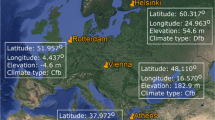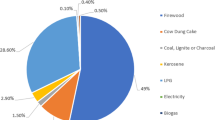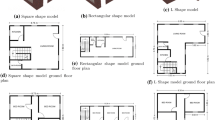Abstract
Since 2003, most European countries established heat health warning systems to alert the population to heat load. Heat health warning systems are based on predicted meteorological conditions outdoors. But the majority of the European population spends a substantial amount of time indoors, and indoor thermal conditions can differ substantially from outdoor conditions. The German Meteorological Service (Deutscher Wetterdienst, DWD) extended the existing heat health warning system (HHWS) with a thermal building simulation model to consider heat load indoors. In this study, the thermal building simulation model is used to simulate a standardized building representing a modern nursing home, because elderly and sick people are most sensitive to heat stress. Different types of natural ventilation were simulated. Based on current and future test reference years, changes in the future heat load indoors were analyzed. Results show differences between the various ventilation options and the possibility to minimize the thermal heat stress during summer by using an appropriate ventilation method. Nighttime ventilation for indoor thermal comfort is most important. A fully opened window at nighttime and the 2-h ventilation in the morning and evening are more sufficient to avoid heat stress than a tilted window at nighttime and the 1-h ventilation in the morning and the evening. Especially the ventilation in the morning seems to be effective to keep the heat load indoors low. Comparing the results for the current and the future test reference years, an increase of heat stress on all ventilation types can be recognized.










Similar content being viewed by others
References
Bastide A, Lauret P, Garde F, Boyer H (2006) Building energy efficiency and thermal comfort in tropical climates presentation of a numerical approach for predicting the percentage of well-ventilated living spaces in buildings using natural ventilation. Energy Build 38(9):1093–1103
Basu R, Samet JM (2002) Relation between elevated ambient temperature and mortality: a review of the epidemiologic evidence. Epidemiol Rev 24:190–202
Bilbao J, Miguel A, Franco JA, Ayuso A (2004) Test reference year generation and evaluation methods in the continental Mediterranean area. J Appl Meteorol 43:390–400
Bull GM, Morton J (1975) Relationships of temperature with death rates from all cause and from certain respiratory and arteriosclerotic diseases in different age groups. Age Ageing 4:232–246
Carrilho da Grac-a G, Chen Q, Glicksman LR, Norford LK (2002) Simulation of wind-driven ventilative cooling systems for an apartment building in Beijing and Shanghai. Energy Build 34(1):1–11
Christoffer J, Deutschländer T, Webs M (2004) Testreferenzjahre von Deutschland für mittlere und extreme Witterungsverhältnisse TRY. Handbuch TRY. Selbstverlag des Deutschen Wetterdienstes, Offenbach a. Main, ISBN Nr.: 3-88148-398-5
Clarke JA, Hensen JLM (1991) An approach to the simulation of coupled heat and mass flows in buildings. Indoor Air 3:283–296
de Miguel A, Bilbao J (2005) Test reference year generation from meteorological and simulated solar radiation data. Solar Energy 78:695–703
EPA (Environmental Protection Agency) (2009) The inside story: a guide to indoor air quality. Available at: /http://www.epa.gov/iaq/pubs/insidest.htmlS (accessed 15 May 2014).
Fanger PO (1972) Thermal comfort. McGraw Hill Book Company, Düsseldorf-New York-London
Geros V, Santamouris M, Tsangrasoulis A, Guarracino G (1999) Experimental evaluation of night ventilation phenomena. Energy Build 29(2):141–154
Givoni B (1998) Climate considerations in building and urban design. John Wiley & Sons Inc
Gratia E, Bruyére I, De Herde A (2004) How to use natural ventilation to cool narrow office buildings. Build Environ 39:1157–1170
Hajat S, Kovats SR, Atkinson R, Haines A (2002) Impact of hot temperatures on death in London: a time series approach. J Epidemiol Community Health 56:367–372
Hall IJ, Prairie RR, Anderson HE, Boes EC (1978) Generation of typical meteorological years for 26 SOL-MET stations. Sandia Laboratories Report SAND 78-1601, Sandia Laboratories, Albuquerque, NM
Höppe PR (1999) The physiological equivalent temperature—a universal index for the biometeorological assessment of the thermal environment. Int J Biometeorol 43:71–75
IPCC (2013) Climate change 2013: the physical science basis. Working Group I Contribution to the Fifth Assessment Report of the Intergovernmental Panel on Climate Change
Jendritzky G, de Dear R, Havenith G (2012) UTCI—why another thermal index? Int J Biometeorol 56:421–428
Klenk J, Becker C, Rapp K (2010) Heat-related mortality in residents of nursing homes. Age Aging 39:245–252
Koppe C (2005) Gesundheitsrelevante Bewertung von thermischer Belastung unter Berücksichtigung der kurzfristigen Anpassung der Bevölkerung an die lokalen Witterungsverhältnisse, Freiburger Dokumentenserver (FreiDok) Albert Ludwigs-Universität-Freiburg, http://www.freidok.uni-freiburg.de/volltexte/1802/
Koppe C, Jendritzky G, Kovats S, Menne B, Baumüller J, Bitan A, Díaz, Jiménez J, Ebi KL, Havenith G, López Santiago C, Michelozzi P, Nicol F, Matzarakis A, McGregor G, Nogueira PJ, Sheridan S, Wolf T (2004) Heat-waves: risks and responses. Regional Office for Europe. Health and Global Environmental Change, Series No. 2. Kopenhagen, Denmark
Kosatzky T (2005) The 2003 European heat waves. Eurosurveillance 10:148–149
Kovats SR, Johnson H, Griffiths C (2006) Mortality in Southern England during the 2003 heat wave by place of death. Health Stat Q 29:6–8
Lipping W, Hien WN (2007) The impacts of ventilation strategies and facade on indoor thermal environment for naturally ventilated residential buildings in Singapore. Build Environ 42:4006–4015
Lye M, Kamal A (1977) Effects of a heatwave on mortality-rates in elderly inpatients. Lancet 1:529–531
Marion W, Urban K (1995) User’s manual for TMY2s: typical meteorological years. National Renewable Energy Laboratory, Golden, CO, USA
Matzarakis A, Mayer H, Iziomon MG (1999) Applications of a universal thermal index: physiological equivalent temperature. Int J Biometeorol 43(2):76–84. doi:10.1007/s004840050119
Matzarakis A, Muthers S, Koch E (2011) Human biometeorological evaluation of heat-related mortality in Vienna. Theor Appl Climatol 105:1–10
Mayer H, Höppe P (1987) Thermal comfort of man in different urban environments. Theor Appl Climatol 38:43–49
Michelozzi P, de Donato F, Bisanti L, Russo A, Cadum E, De Maria M, D’Ovidio M, Costa G, Perucci CA (2005) The impact of the summer 2003 heat waves on mortality in four Italian cities. Euro Surveill 10(7):161–165
Nastos PT, Matzarakis A (2012) The effect of air temperature and human thermal indices on mortality in Athens. Theor Appl Climatol 108:591–599
Petrakis M, Lykoudis S, Kassomenos P (1996) A software tool for the creation of a typical meteorological year. Environ Softw 11(4):221–227
Pfafferott J (2012) Vorhersage zur Wärmebelastung in Innenräumen
Pfafferott J, Becker P (2008) Erweiterung des hitzewarnsystems um die vorhersage der wärmebelastung in innenräumen. Bauphysik 30:237–243
Pfafferott J, Koppe C, Reez C (2011) Extension of the heat health warning system by indoor heat prediction. International Conference October, Karlsruhe, Germany 15–26
Pissimanis D, Karras G, Notaridou V, Gavra K (1988) The generation of a ‘typical meteorological year’ for the city of Athens. Sol Energy 40:405–411
Roeckner E, Bäuml G, Bonaventura L, Brokopf R, Esch M, Giorgetta M, Hagemann S, Kirchner I, Kornblueh L, Manzini E, Rhodin A, Schlese U, Schulzweida U, Tompkins A (2003) The atmospheric general circulation model ECHAM 5. Part 1: model description. Hamburg: Max-Plank-Institute for Meteorology
Santamouris M, Sfakianaki A, Pavlou K (2010) On the efficiency of night ventilation techniques applied to residential buildings. Energy Build 42(8):1309–1313
Smargiassi A, Fournier M, Griot C, Baudouin Y, Kosatzky T (2008) Prediction of the indoor temperatures of an urban area with an in-time regression mapping approach. J Expo Sci Environ Epidemiol 18:282–288
Staiger H, Laschewski G, Graetz A (2012) The perceived temperature—a versatile index for the assessment of the human thermal environment. Part A: scientific basics. Int J Biometeorol 56(1):165–176. doi:10.1007/s00484-011-0409-6
Wang L, Wong NH (2007) The impacts of ventilation strategies and facade on indoor thermal environment for naturally ventilated residential buildings in Singapore. Build Environ 42(12):4006–4015
White-Newsome JL, Sanchez BN, Jolliet O, Zhang Z, Parker EA, Dvonch JT, O’Neill MS (2012) Climate change and health: indoor heat exposure in vulnerable populations. Environ Res 112:20–27
Author information
Authors and Affiliations
Corresponding author
Rights and permissions
About this article
Cite this article
Rosenfelder, M., Koppe, C., Pfafferott, J. et al. Effects of ventilation behaviour on indoor heat load based on test reference years. Int J Biometeorol 60, 277–287 (2016). https://doi.org/10.1007/s00484-015-1024-8
Received:
Revised:
Accepted:
Published:
Issue Date:
DOI: https://doi.org/10.1007/s00484-015-1024-8




